Electrical Engineering Project: Solar Street Lighting System
VerifiedAdded on 2022/09/05
|34
|5392
|27
Project
AI Summary
This electrical engineering project presents a theoretical design for a smart solar-powered streetlamp light control system. The project encompasses a detailed analysis of the system's components, including solar panels, batteries, and LED luminaires. It covers luminaire calculations, sizing of the solar PV system, and calculations for posts. The document includes considerations for environmental factors like temperature and cloud cover, and their impact on solar insolation. Detailed calculations for lighting intensity, wattage, and battery storage are provided. A budget analysis, including monetary and time aspects, is also included. The project aims to demonstrate a practical understanding of electrical engineering principles in the context of renewable energy applications, providing a comprehensive approach to designing and implementing a solar street lighting solution.
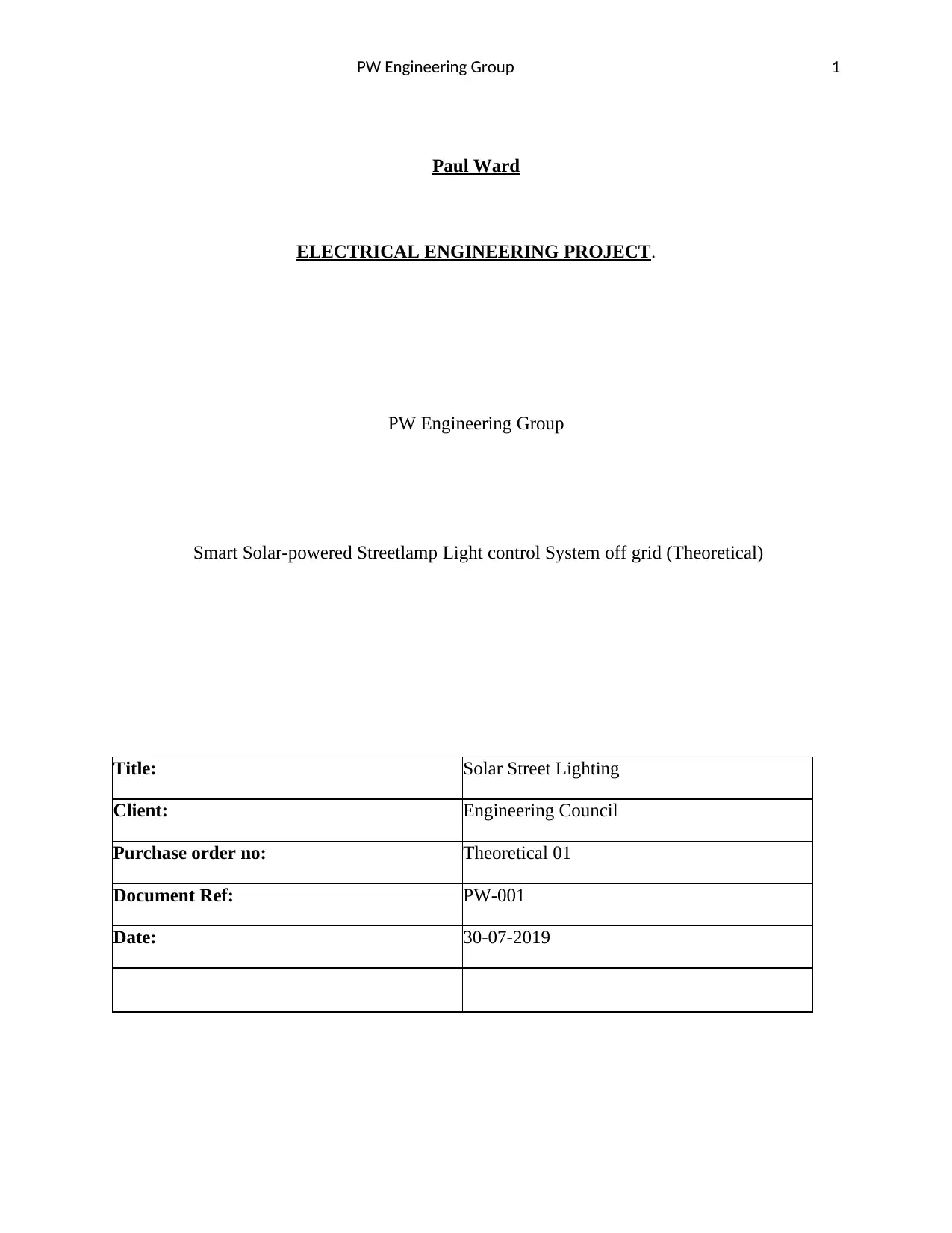
PW Engineering Group 1
Paul Ward
ELECTRICAL ENGINEERING PROJECT.
PW Engineering Group
Smart Solar-powered Streetlamp Light control System off grid (Theoretical)
Title: Solar Street Lighting
Client: Engineering Council
Purchase order no: Theoretical 01
Document Ref: PW-001
Date: 30-07-2019
Paul Ward
ELECTRICAL ENGINEERING PROJECT.
PW Engineering Group
Smart Solar-powered Streetlamp Light control System off grid (Theoretical)
Title: Solar Street Lighting
Client: Engineering Council
Purchase order no: Theoretical 01
Document Ref: PW-001
Date: 30-07-2019
Paraphrase This Document
Need a fresh take? Get an instant paraphrase of this document with our AI Paraphraser
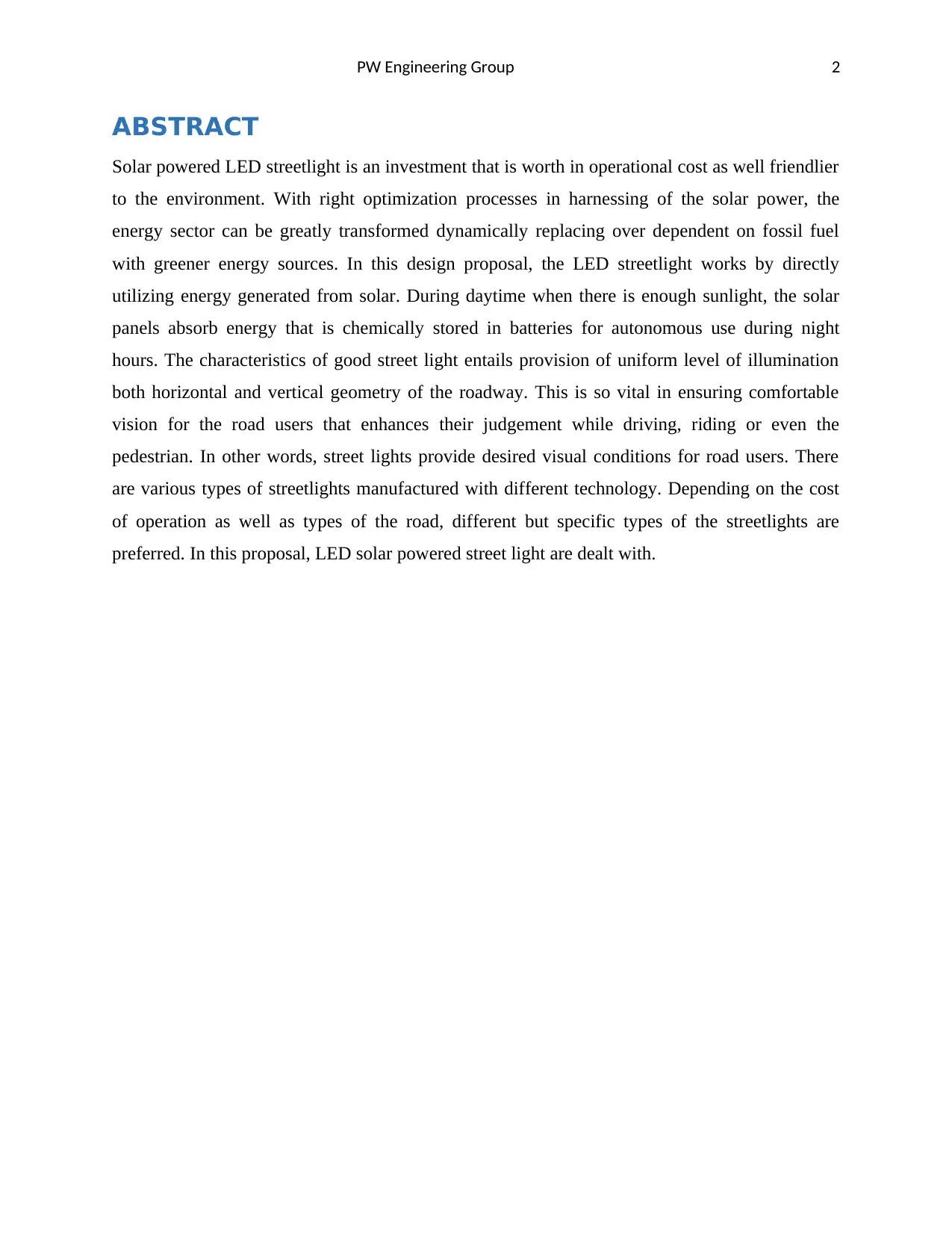
PW Engineering Group 2
ABSTRACT
Solar powered LED streetlight is an investment that is worth in operational cost as well friendlier
to the environment. With right optimization processes in harnessing of the solar power, the
energy sector can be greatly transformed dynamically replacing over dependent on fossil fuel
with greener energy sources. In this design proposal, the LED streetlight works by directly
utilizing energy generated from solar. During daytime when there is enough sunlight, the solar
panels absorb energy that is chemically stored in batteries for autonomous use during night
hours. The characteristics of good street light entails provision of uniform level of illumination
both horizontal and vertical geometry of the roadway. This is so vital in ensuring comfortable
vision for the road users that enhances their judgement while driving, riding or even the
pedestrian. In other words, street lights provide desired visual conditions for road users. There
are various types of streetlights manufactured with different technology. Depending on the cost
of operation as well as types of the road, different but specific types of the streetlights are
preferred. In this proposal, LED solar powered street light are dealt with.
ABSTRACT
Solar powered LED streetlight is an investment that is worth in operational cost as well friendlier
to the environment. With right optimization processes in harnessing of the solar power, the
energy sector can be greatly transformed dynamically replacing over dependent on fossil fuel
with greener energy sources. In this design proposal, the LED streetlight works by directly
utilizing energy generated from solar. During daytime when there is enough sunlight, the solar
panels absorb energy that is chemically stored in batteries for autonomous use during night
hours. The characteristics of good street light entails provision of uniform level of illumination
both horizontal and vertical geometry of the roadway. This is so vital in ensuring comfortable
vision for the road users that enhances their judgement while driving, riding or even the
pedestrian. In other words, street lights provide desired visual conditions for road users. There
are various types of streetlights manufactured with different technology. Depending on the cost
of operation as well as types of the road, different but specific types of the streetlights are
preferred. In this proposal, LED solar powered street light are dealt with.
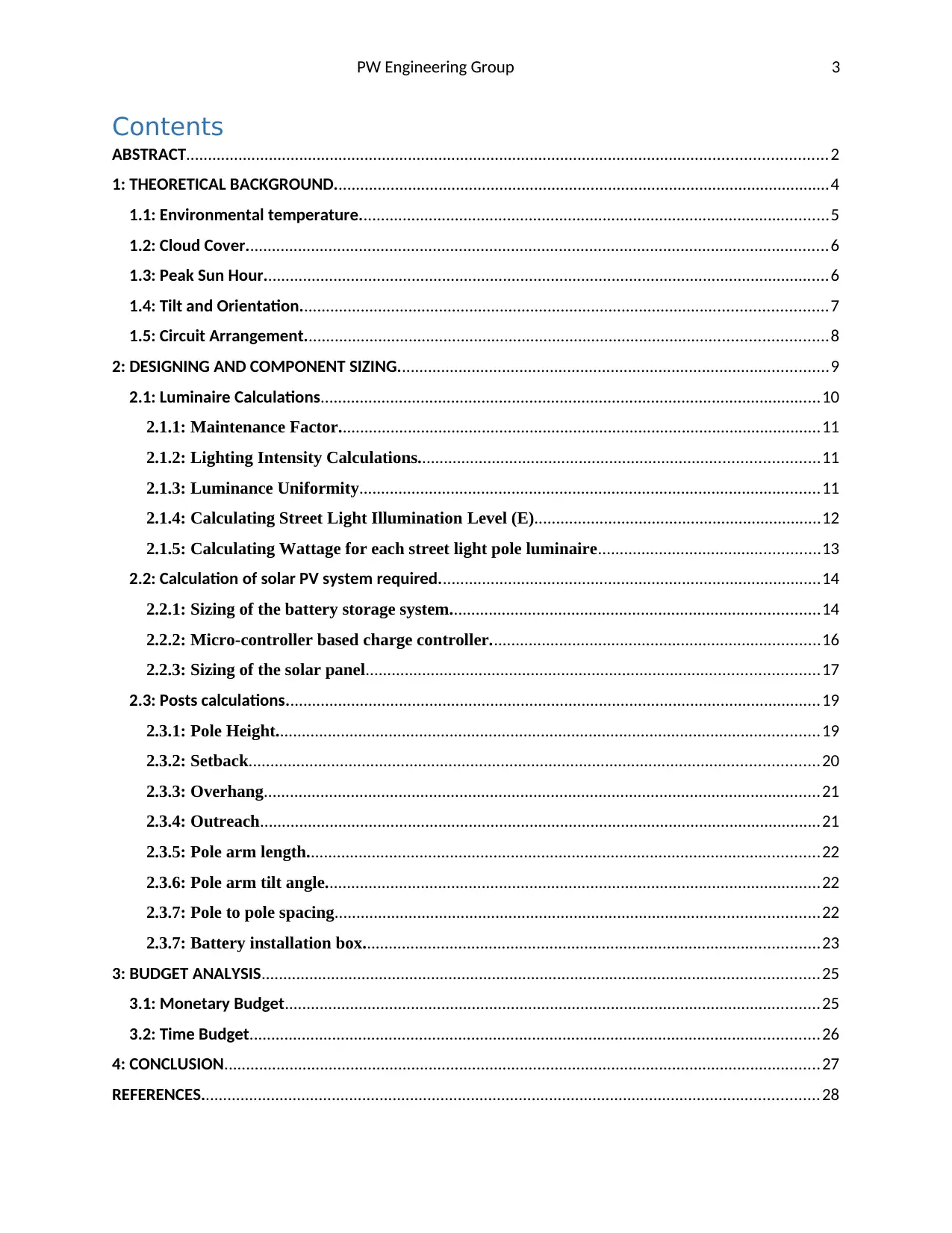
PW Engineering Group 3
Contents
ABSTRACT...................................................................................................................................................2
1: THEORETICAL BACKGROUND..................................................................................................................4
1.1: Environmental temperature............................................................................................................5
1.2: Cloud Cover......................................................................................................................................6
1.3: Peak Sun Hour..................................................................................................................................6
1.4: Tilt and Orientation.........................................................................................................................7
1.5: Circuit Arrangement........................................................................................................................8
2: DESIGNING AND COMPONENT SIZING...................................................................................................9
2.1: Luminaire Calculations...................................................................................................................10
2.1.1: Maintenance Factor...............................................................................................................11
2.1.2: Lighting Intensity Calculations............................................................................................11
2.1.3: Luminance Uniformity..........................................................................................................11
2.1.4: Calculating Street Light Illumination Level (E)..................................................................12
2.1.5: Calculating Wattage for each street light pole luminaire...................................................13
2.2: Calculation of solar PV system required........................................................................................14
2.2.1: Sizing of the battery storage system.....................................................................................14
2.2.2: Micro-controller based charge controller............................................................................16
2.2.3: Sizing of the solar panel........................................................................................................17
2.3: Posts calculations...........................................................................................................................19
2.3.1: Pole Height.............................................................................................................................19
2.3.2: Setback...................................................................................................................................20
2.3.3: Overhang................................................................................................................................21
2.3.4: Outreach.................................................................................................................................21
2.3.5: Pole arm length......................................................................................................................22
2.3.6: Pole arm tilt angle..................................................................................................................22
2.3.7: Pole to pole spacing...............................................................................................................22
2.3.7: Battery installation box.........................................................................................................23
3: BUDGET ANALYSIS................................................................................................................................25
3.1: Monetary Budget...........................................................................................................................25
3.2: Time Budget...................................................................................................................................26
4: CONCLUSION.........................................................................................................................................27
REFERENCES..............................................................................................................................................28
Contents
ABSTRACT...................................................................................................................................................2
1: THEORETICAL BACKGROUND..................................................................................................................4
1.1: Environmental temperature............................................................................................................5
1.2: Cloud Cover......................................................................................................................................6
1.3: Peak Sun Hour..................................................................................................................................6
1.4: Tilt and Orientation.........................................................................................................................7
1.5: Circuit Arrangement........................................................................................................................8
2: DESIGNING AND COMPONENT SIZING...................................................................................................9
2.1: Luminaire Calculations...................................................................................................................10
2.1.1: Maintenance Factor...............................................................................................................11
2.1.2: Lighting Intensity Calculations............................................................................................11
2.1.3: Luminance Uniformity..........................................................................................................11
2.1.4: Calculating Street Light Illumination Level (E)..................................................................12
2.1.5: Calculating Wattage for each street light pole luminaire...................................................13
2.2: Calculation of solar PV system required........................................................................................14
2.2.1: Sizing of the battery storage system.....................................................................................14
2.2.2: Micro-controller based charge controller............................................................................16
2.2.3: Sizing of the solar panel........................................................................................................17
2.3: Posts calculations...........................................................................................................................19
2.3.1: Pole Height.............................................................................................................................19
2.3.2: Setback...................................................................................................................................20
2.3.3: Overhang................................................................................................................................21
2.3.4: Outreach.................................................................................................................................21
2.3.5: Pole arm length......................................................................................................................22
2.3.6: Pole arm tilt angle..................................................................................................................22
2.3.7: Pole to pole spacing...............................................................................................................22
2.3.7: Battery installation box.........................................................................................................23
3: BUDGET ANALYSIS................................................................................................................................25
3.1: Monetary Budget...........................................................................................................................25
3.2: Time Budget...................................................................................................................................26
4: CONCLUSION.........................................................................................................................................27
REFERENCES..............................................................................................................................................28
⊘ This is a preview!⊘
Do you want full access?
Subscribe today to unlock all pages.

Trusted by 1+ million students worldwide

PW Engineering Group 4
APPENDIX 1...............................................................................................................................................30
Lithium-ion battery pack; ION012120T16............................................................................................30
APPENDIX 2...............................................................................................................................................31
Off-grid LD135R9W LG solar panel.......................................................................................................31
APPENDIX 3...............................................................................................................................................32
30W LED streetlight..............................................................................................................................32
APPENDIX 4...............................................................................................................................................33
Micro controller based charge controller.............................................................................................33
APPENDIX 1...............................................................................................................................................30
Lithium-ion battery pack; ION012120T16............................................................................................30
APPENDIX 2...............................................................................................................................................31
Off-grid LD135R9W LG solar panel.......................................................................................................31
APPENDIX 3...............................................................................................................................................32
30W LED streetlight..............................................................................................................................32
APPENDIX 4...............................................................................................................................................33
Micro controller based charge controller.............................................................................................33
Paraphrase This Document
Need a fresh take? Get an instant paraphrase of this document with our AI Paraphraser
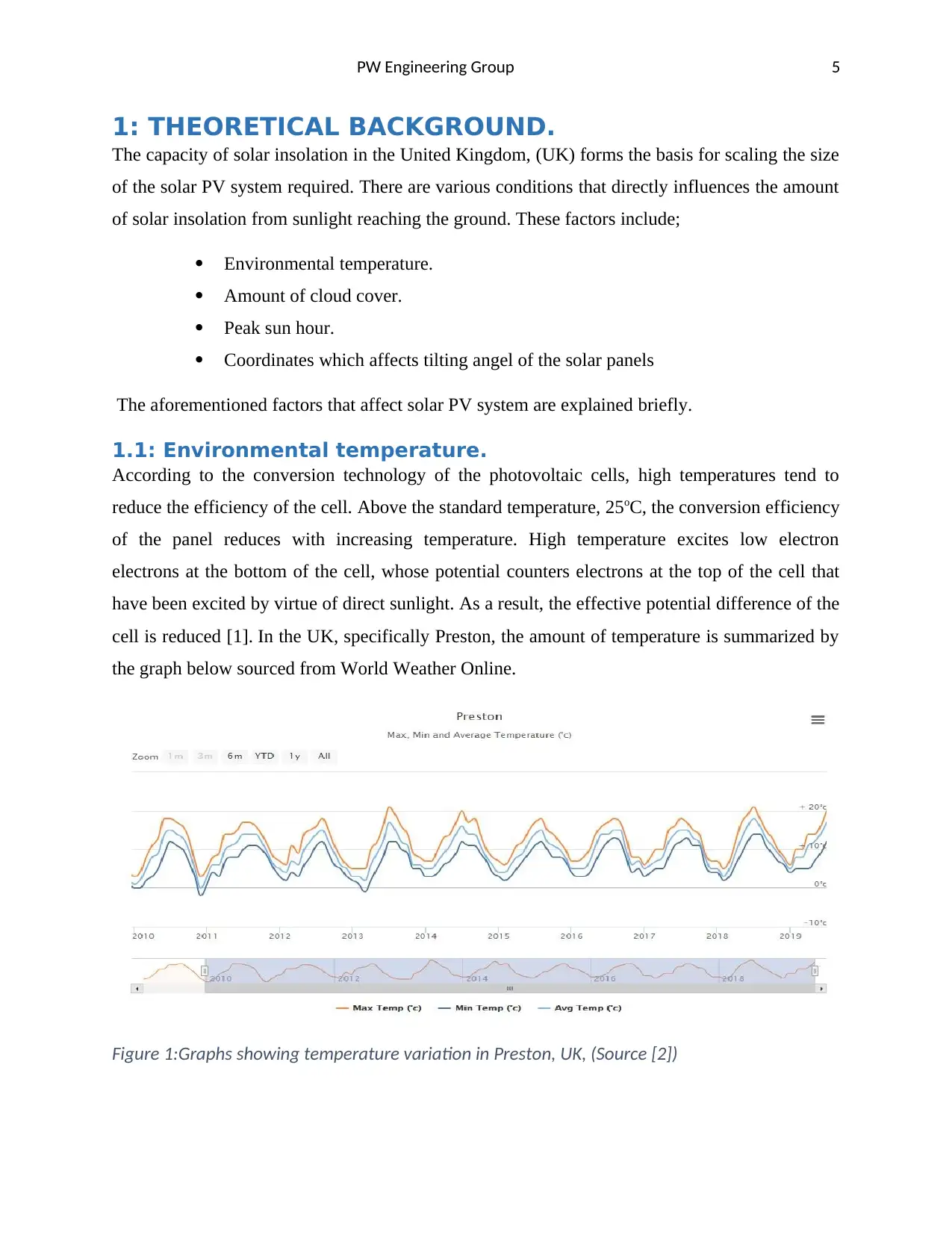
PW Engineering Group 5
1: THEORETICAL BACKGROUND.
The capacity of solar insolation in the United Kingdom, (UK) forms the basis for scaling the size
of the solar PV system required. There are various conditions that directly influences the amount
of solar insolation from sunlight reaching the ground. These factors include;
Environmental temperature.
Amount of cloud cover.
Peak sun hour.
Coordinates which affects tilting angel of the solar panels
The aforementioned factors that affect solar PV system are explained briefly.
1.1: Environmental temperature.
According to the conversion technology of the photovoltaic cells, high temperatures tend to
reduce the efficiency of the cell. Above the standard temperature, 25oC, the conversion efficiency
of the panel reduces with increasing temperature. High temperature excites low electron
electrons at the bottom of the cell, whose potential counters electrons at the top of the cell that
have been excited by virtue of direct sunlight. As a result, the effective potential difference of the
cell is reduced [1]. In the UK, specifically Preston, the amount of temperature is summarized by
the graph below sourced from World Weather Online.
Figure 1:Graphs showing temperature variation in Preston, UK, (Source [2])
1: THEORETICAL BACKGROUND.
The capacity of solar insolation in the United Kingdom, (UK) forms the basis for scaling the size
of the solar PV system required. There are various conditions that directly influences the amount
of solar insolation from sunlight reaching the ground. These factors include;
Environmental temperature.
Amount of cloud cover.
Peak sun hour.
Coordinates which affects tilting angel of the solar panels
The aforementioned factors that affect solar PV system are explained briefly.
1.1: Environmental temperature.
According to the conversion technology of the photovoltaic cells, high temperatures tend to
reduce the efficiency of the cell. Above the standard temperature, 25oC, the conversion efficiency
of the panel reduces with increasing temperature. High temperature excites low electron
electrons at the bottom of the cell, whose potential counters electrons at the top of the cell that
have been excited by virtue of direct sunlight. As a result, the effective potential difference of the
cell is reduced [1]. In the UK, specifically Preston, the amount of temperature is summarized by
the graph below sourced from World Weather Online.
Figure 1:Graphs showing temperature variation in Preston, UK, (Source [2])
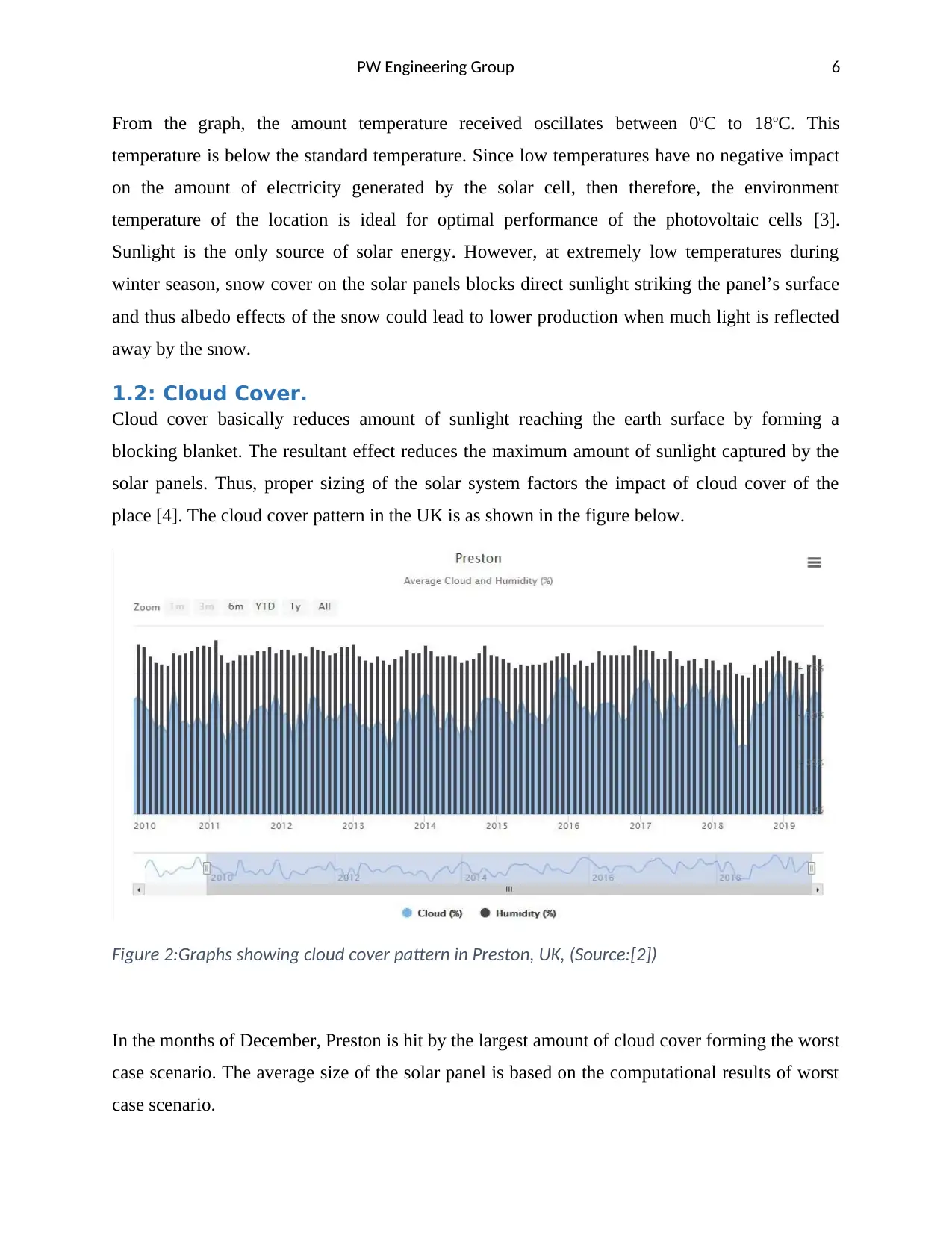
PW Engineering Group 6
From the graph, the amount temperature received oscillates between 0oC to 18oC. This
temperature is below the standard temperature. Since low temperatures have no negative impact
on the amount of electricity generated by the solar cell, then therefore, the environment
temperature of the location is ideal for optimal performance of the photovoltaic cells [3].
Sunlight is the only source of solar energy. However, at extremely low temperatures during
winter season, snow cover on the solar panels blocks direct sunlight striking the panel’s surface
and thus albedo effects of the snow could lead to lower production when much light is reflected
away by the snow.
1.2: Cloud Cover.
Cloud cover basically reduces amount of sunlight reaching the earth surface by forming a
blocking blanket. The resultant effect reduces the maximum amount of sunlight captured by the
solar panels. Thus, proper sizing of the solar system factors the impact of cloud cover of the
place [4]. The cloud cover pattern in the UK is as shown in the figure below.
Figure 2:Graphs showing cloud cover pattern in Preston, UK, (Source:[2])
In the months of December, Preston is hit by the largest amount of cloud cover forming the worst
case scenario. The average size of the solar panel is based on the computational results of worst
case scenario.
From the graph, the amount temperature received oscillates between 0oC to 18oC. This
temperature is below the standard temperature. Since low temperatures have no negative impact
on the amount of electricity generated by the solar cell, then therefore, the environment
temperature of the location is ideal for optimal performance of the photovoltaic cells [3].
Sunlight is the only source of solar energy. However, at extremely low temperatures during
winter season, snow cover on the solar panels blocks direct sunlight striking the panel’s surface
and thus albedo effects of the snow could lead to lower production when much light is reflected
away by the snow.
1.2: Cloud Cover.
Cloud cover basically reduces amount of sunlight reaching the earth surface by forming a
blocking blanket. The resultant effect reduces the maximum amount of sunlight captured by the
solar panels. Thus, proper sizing of the solar system factors the impact of cloud cover of the
place [4]. The cloud cover pattern in the UK is as shown in the figure below.
Figure 2:Graphs showing cloud cover pattern in Preston, UK, (Source:[2])
In the months of December, Preston is hit by the largest amount of cloud cover forming the worst
case scenario. The average size of the solar panel is based on the computational results of worst
case scenario.
⊘ This is a preview!⊘
Do you want full access?
Subscribe today to unlock all pages.

Trusted by 1+ million students worldwide
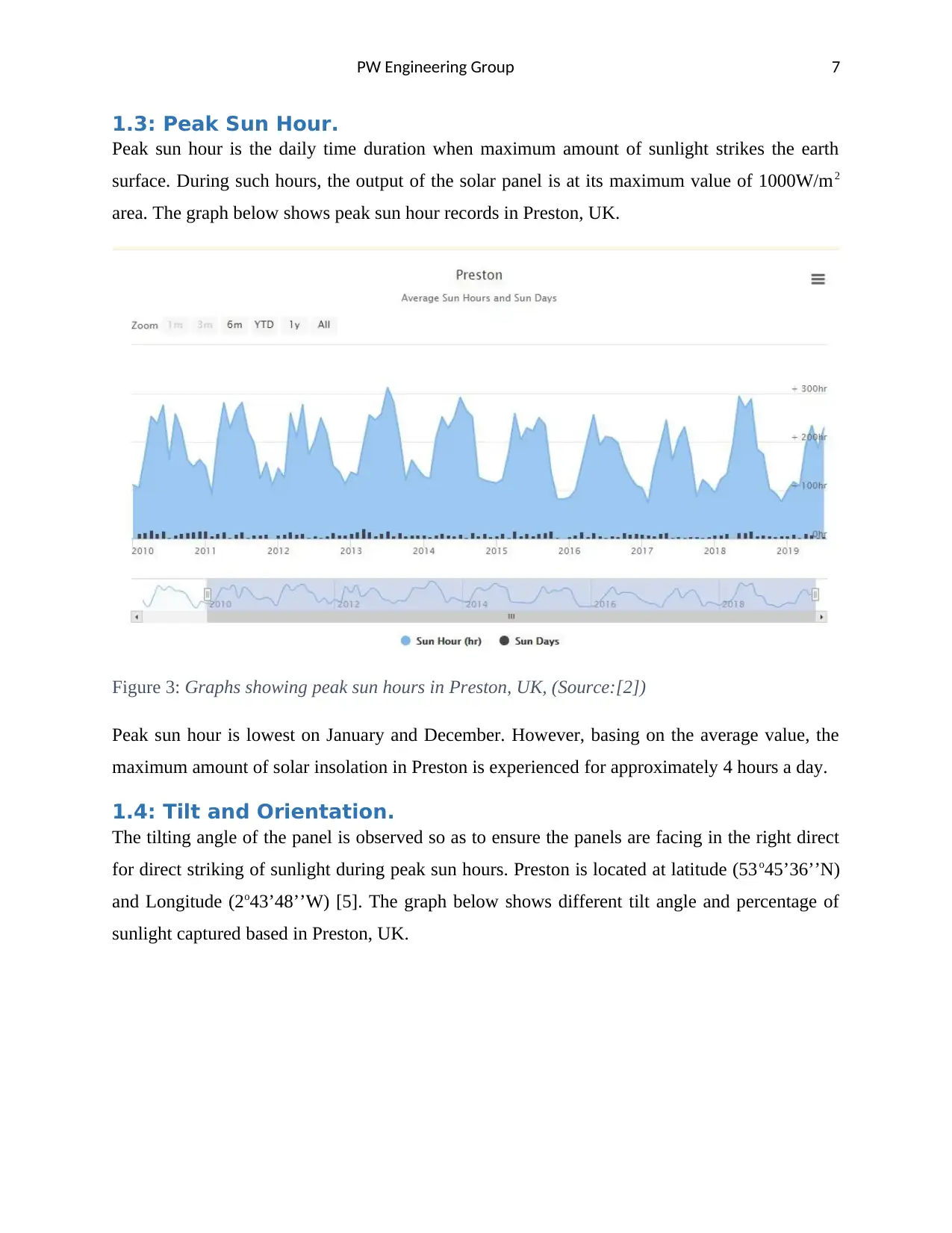
PW Engineering Group 7
1.3: Peak Sun Hour.
Peak sun hour is the daily time duration when maximum amount of sunlight strikes the earth
surface. During such hours, the output of the solar panel is at its maximum value of 1000W/m2
area. The graph below shows peak sun hour records in Preston, UK.
Figure 3: Graphs showing peak sun hours in Preston, UK, (Source:[2])
Peak sun hour is lowest on January and December. However, basing on the average value, the
maximum amount of solar insolation in Preston is experienced for approximately 4 hours a day.
1.4: Tilt and Orientation.
The tilting angle of the panel is observed so as to ensure the panels are facing in the right direct
for direct striking of sunlight during peak sun hours. Preston is located at latitude (53o45’36’’N)
and Longitude (2o43’48’’W) [5]. The graph below shows different tilt angle and percentage of
sunlight captured based in Preston, UK.
1.3: Peak Sun Hour.
Peak sun hour is the daily time duration when maximum amount of sunlight strikes the earth
surface. During such hours, the output of the solar panel is at its maximum value of 1000W/m2
area. The graph below shows peak sun hour records in Preston, UK.
Figure 3: Graphs showing peak sun hours in Preston, UK, (Source:[2])
Peak sun hour is lowest on January and December. However, basing on the average value, the
maximum amount of solar insolation in Preston is experienced for approximately 4 hours a day.
1.4: Tilt and Orientation.
The tilting angle of the panel is observed so as to ensure the panels are facing in the right direct
for direct striking of sunlight during peak sun hours. Preston is located at latitude (53o45’36’’N)
and Longitude (2o43’48’’W) [5]. The graph below shows different tilt angle and percentage of
sunlight captured based in Preston, UK.
Paraphrase This Document
Need a fresh take? Get an instant paraphrase of this document with our AI Paraphraser
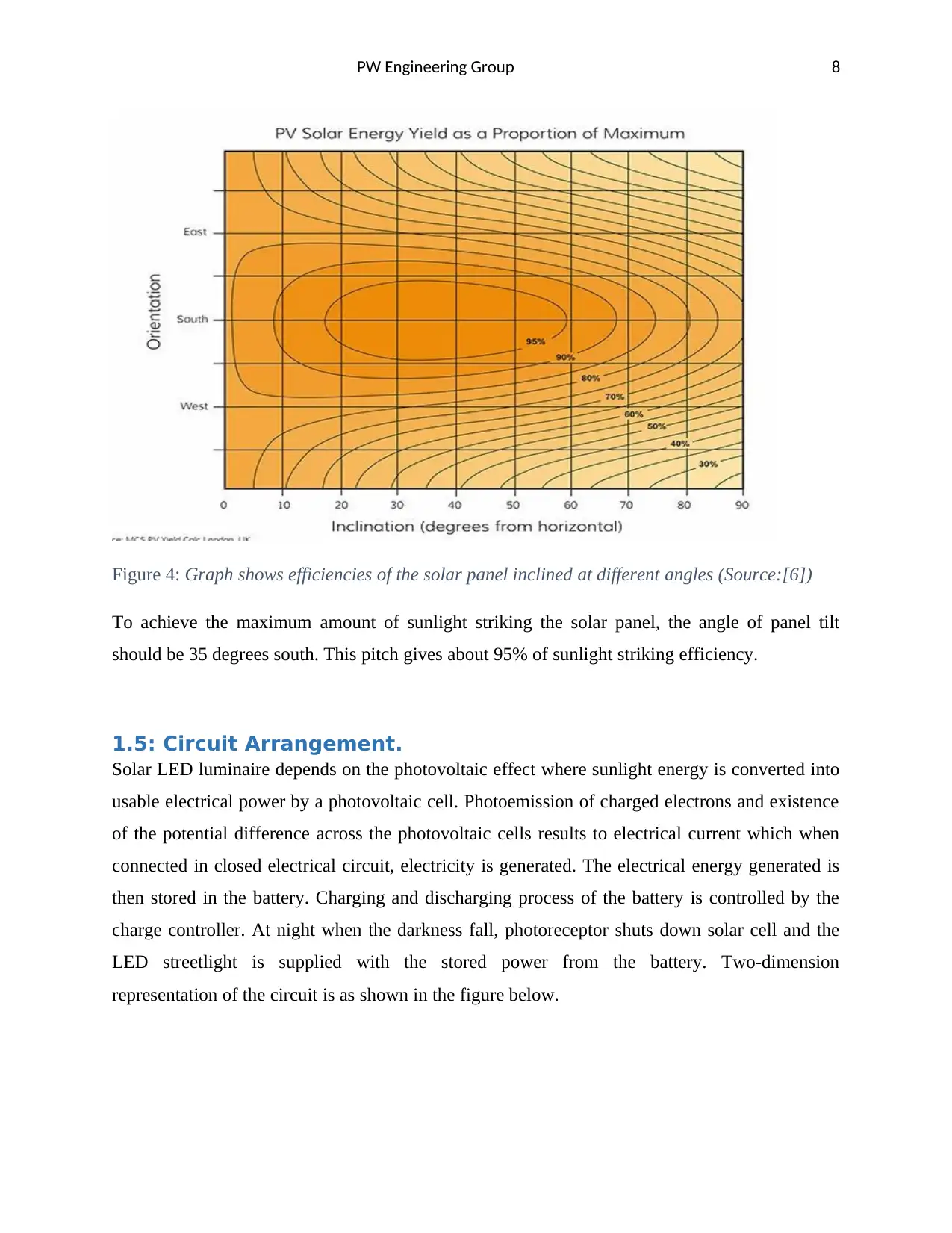
PW Engineering Group 8
Figure 4: Graph shows efficiencies of the solar panel inclined at different angles (Source:[6])
To achieve the maximum amount of sunlight striking the solar panel, the angle of panel tilt
should be 35 degrees south. This pitch gives about 95% of sunlight striking efficiency.
1.5: Circuit Arrangement.
Solar LED luminaire depends on the photovoltaic effect where sunlight energy is converted into
usable electrical power by a photovoltaic cell. Photoemission of charged electrons and existence
of the potential difference across the photovoltaic cells results to electrical current which when
connected in closed electrical circuit, electricity is generated. The electrical energy generated is
then stored in the battery. Charging and discharging process of the battery is controlled by the
charge controller. At night when the darkness fall, photoreceptor shuts down solar cell and the
LED streetlight is supplied with the stored power from the battery. Two-dimension
representation of the circuit is as shown in the figure below.
Figure 4: Graph shows efficiencies of the solar panel inclined at different angles (Source:[6])
To achieve the maximum amount of sunlight striking the solar panel, the angle of panel tilt
should be 35 degrees south. This pitch gives about 95% of sunlight striking efficiency.
1.5: Circuit Arrangement.
Solar LED luminaire depends on the photovoltaic effect where sunlight energy is converted into
usable electrical power by a photovoltaic cell. Photoemission of charged electrons and existence
of the potential difference across the photovoltaic cells results to electrical current which when
connected in closed electrical circuit, electricity is generated. The electrical energy generated is
then stored in the battery. Charging and discharging process of the battery is controlled by the
charge controller. At night when the darkness fall, photoreceptor shuts down solar cell and the
LED streetlight is supplied with the stored power from the battery. Two-dimension
representation of the circuit is as shown in the figure below.
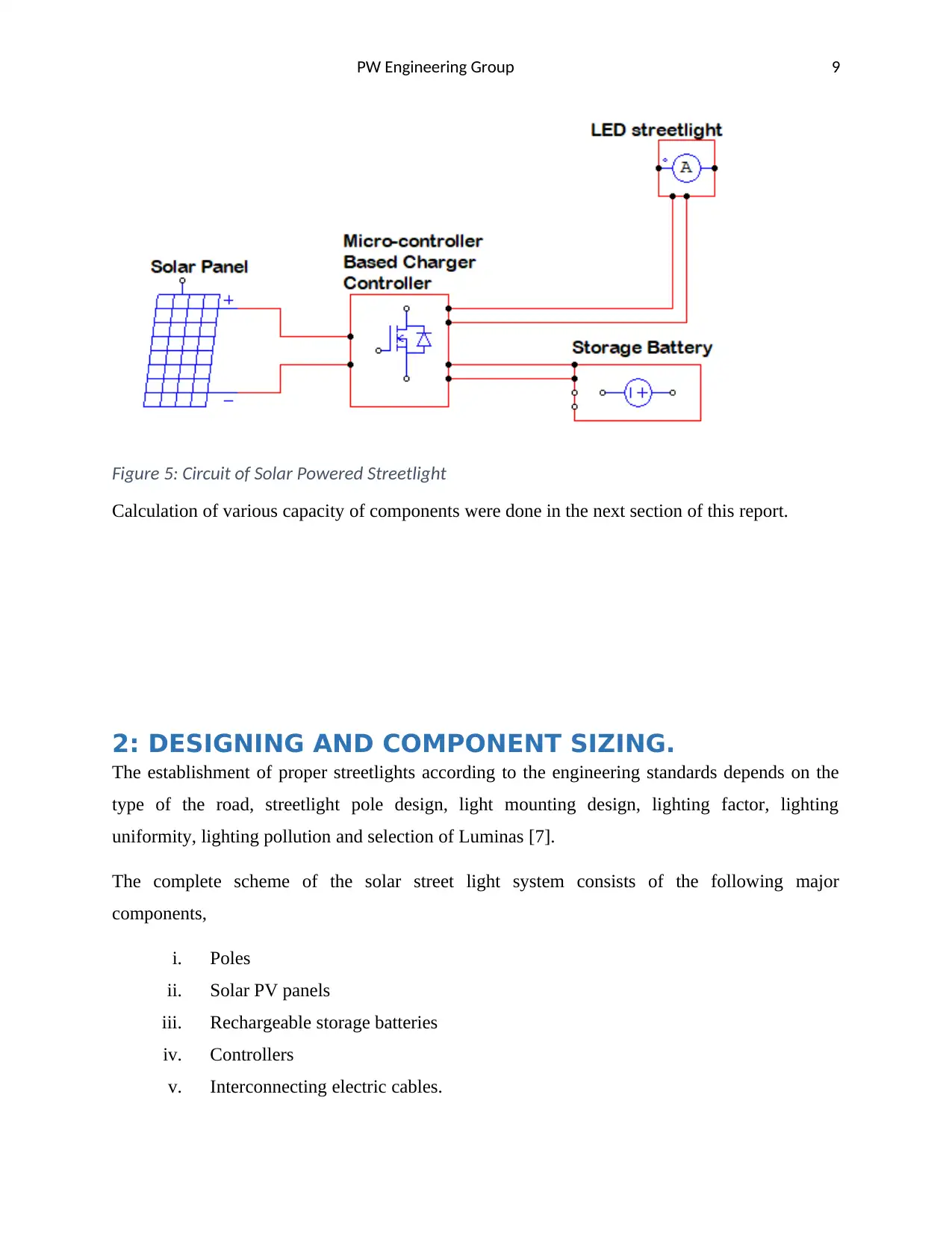
PW Engineering Group 9
Figure 5: Circuit of Solar Powered Streetlight
Calculation of various capacity of components were done in the next section of this report.
2: DESIGNING AND COMPONENT SIZING.
The establishment of proper streetlights according to the engineering standards depends on the
type of the road, streetlight pole design, light mounting design, lighting factor, lighting
uniformity, lighting pollution and selection of Luminas [7].
The complete scheme of the solar street light system consists of the following major
components,
i. Poles
ii. Solar PV panels
iii. Rechargeable storage batteries
iv. Controllers
v. Interconnecting electric cables.
Figure 5: Circuit of Solar Powered Streetlight
Calculation of various capacity of components were done in the next section of this report.
2: DESIGNING AND COMPONENT SIZING.
The establishment of proper streetlights according to the engineering standards depends on the
type of the road, streetlight pole design, light mounting design, lighting factor, lighting
uniformity, lighting pollution and selection of Luminas [7].
The complete scheme of the solar street light system consists of the following major
components,
i. Poles
ii. Solar PV panels
iii. Rechargeable storage batteries
iv. Controllers
v. Interconnecting electric cables.
⊘ This is a preview!⊘
Do you want full access?
Subscribe today to unlock all pages.

Trusted by 1+ million students worldwide
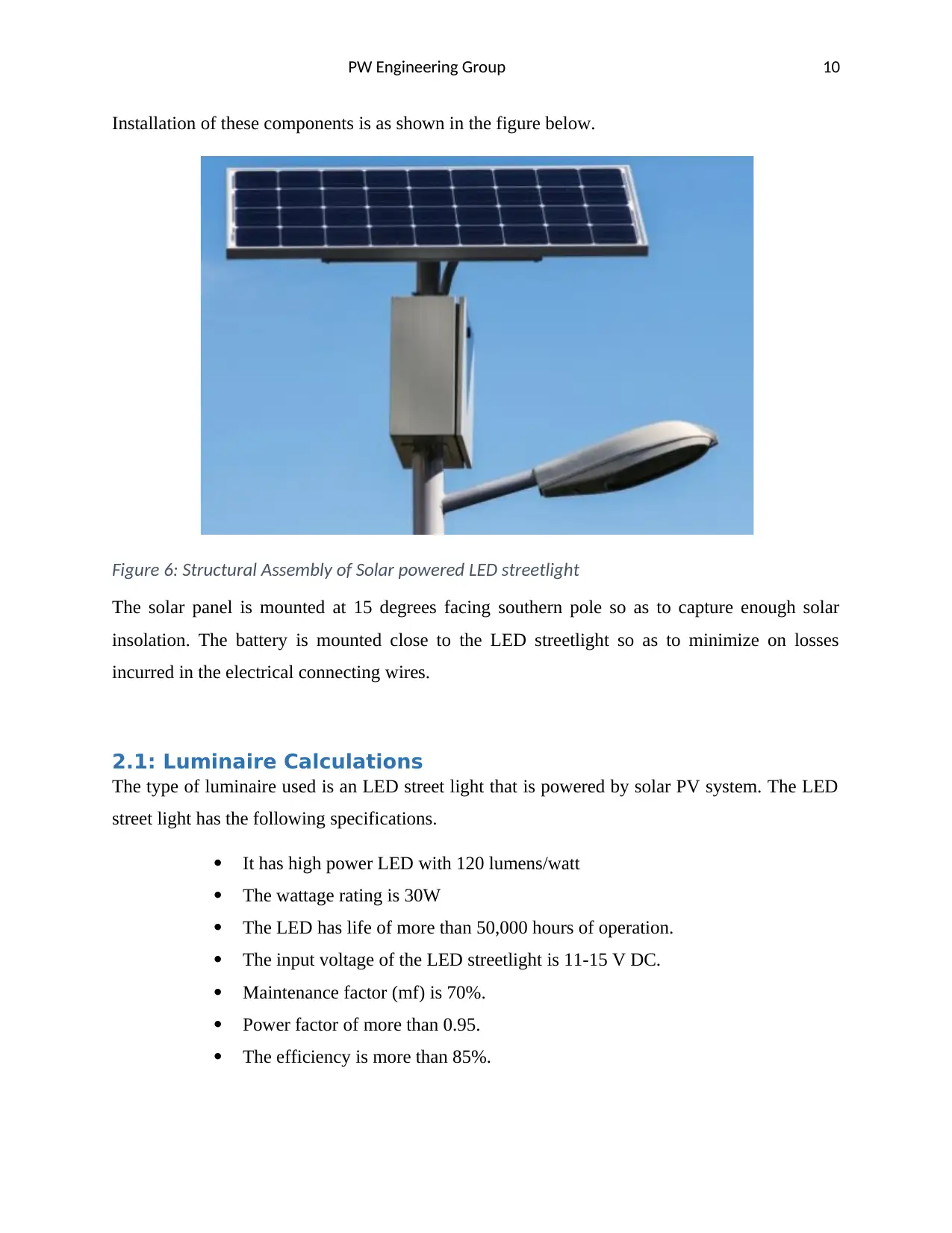
PW Engineering Group 10
Installation of these components is as shown in the figure below.
Figure 6: Structural Assembly of Solar powered LED streetlight
The solar panel is mounted at 15 degrees facing southern pole so as to capture enough solar
insolation. The battery is mounted close to the LED streetlight so as to minimize on losses
incurred in the electrical connecting wires.
2.1: Luminaire Calculations
The type of luminaire used is an LED street light that is powered by solar PV system. The LED
street light has the following specifications.
It has high power LED with 120 lumens/watt
The wattage rating is 30W
The LED has life of more than 50,000 hours of operation.
The input voltage of the LED streetlight is 11-15 V DC.
Maintenance factor (mf) is 70%.
Power factor of more than 0.95.
The efficiency is more than 85%.
Installation of these components is as shown in the figure below.
Figure 6: Structural Assembly of Solar powered LED streetlight
The solar panel is mounted at 15 degrees facing southern pole so as to capture enough solar
insolation. The battery is mounted close to the LED streetlight so as to minimize on losses
incurred in the electrical connecting wires.
2.1: Luminaire Calculations
The type of luminaire used is an LED street light that is powered by solar PV system. The LED
street light has the following specifications.
It has high power LED with 120 lumens/watt
The wattage rating is 30W
The LED has life of more than 50,000 hours of operation.
The input voltage of the LED streetlight is 11-15 V DC.
Maintenance factor (mf) is 70%.
Power factor of more than 0.95.
The efficiency is more than 85%.
Paraphrase This Document
Need a fresh take? Get an instant paraphrase of this document with our AI Paraphraser
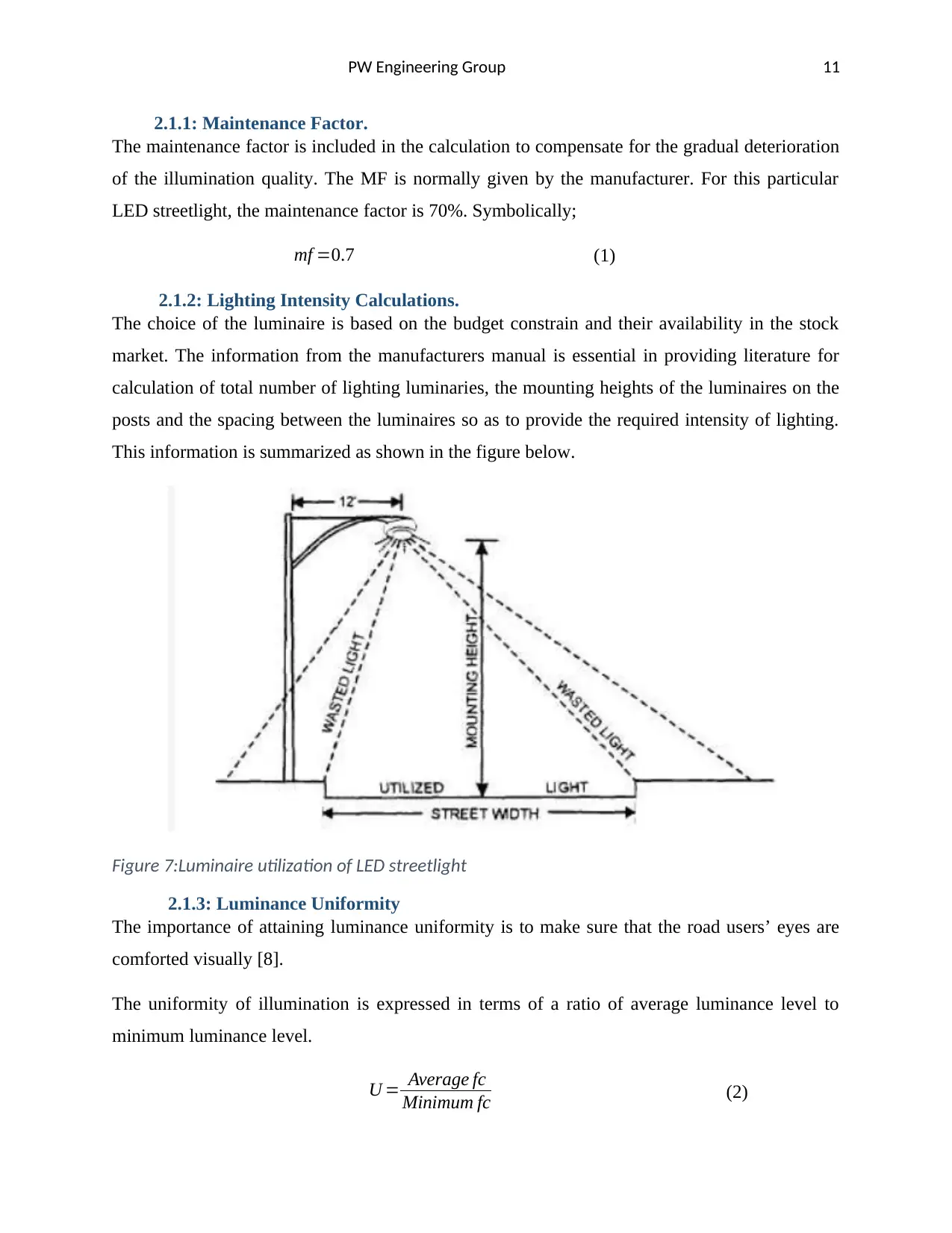
PW Engineering Group 11
2.1.1: Maintenance Factor.
The maintenance factor is included in the calculation to compensate for the gradual deterioration
of the illumination quality. The MF is normally given by the manufacturer. For this particular
LED streetlight, the maintenance factor is 70%. Symbolically;
mf =0.7 (1)
2.1.2: Lighting Intensity Calculations.
The choice of the luminaire is based on the budget constrain and their availability in the stock
market. The information from the manufacturers manual is essential in providing literature for
calculation of total number of lighting luminaries, the mounting heights of the luminaires on the
posts and the spacing between the luminaires so as to provide the required intensity of lighting.
This information is summarized as shown in the figure below.
Figure 7:Luminaire utilization of LED streetlight
2.1.3: Luminance Uniformity
The importance of attaining luminance uniformity is to make sure that the road users’ eyes are
comforted visually [8].
The uniformity of illumination is expressed in terms of a ratio of average luminance level to
minimum luminance level.
U = Average fc
Minimum fc (2)
2.1.1: Maintenance Factor.
The maintenance factor is included in the calculation to compensate for the gradual deterioration
of the illumination quality. The MF is normally given by the manufacturer. For this particular
LED streetlight, the maintenance factor is 70%. Symbolically;
mf =0.7 (1)
2.1.2: Lighting Intensity Calculations.
The choice of the luminaire is based on the budget constrain and their availability in the stock
market. The information from the manufacturers manual is essential in providing literature for
calculation of total number of lighting luminaries, the mounting heights of the luminaires on the
posts and the spacing between the luminaires so as to provide the required intensity of lighting.
This information is summarized as shown in the figure below.
Figure 7:Luminaire utilization of LED streetlight
2.1.3: Luminance Uniformity
The importance of attaining luminance uniformity is to make sure that the road users’ eyes are
comforted visually [8].
The uniformity of illumination is expressed in terms of a ratio of average luminance level to
minimum luminance level.
U = Average fc
Minimum fc (2)
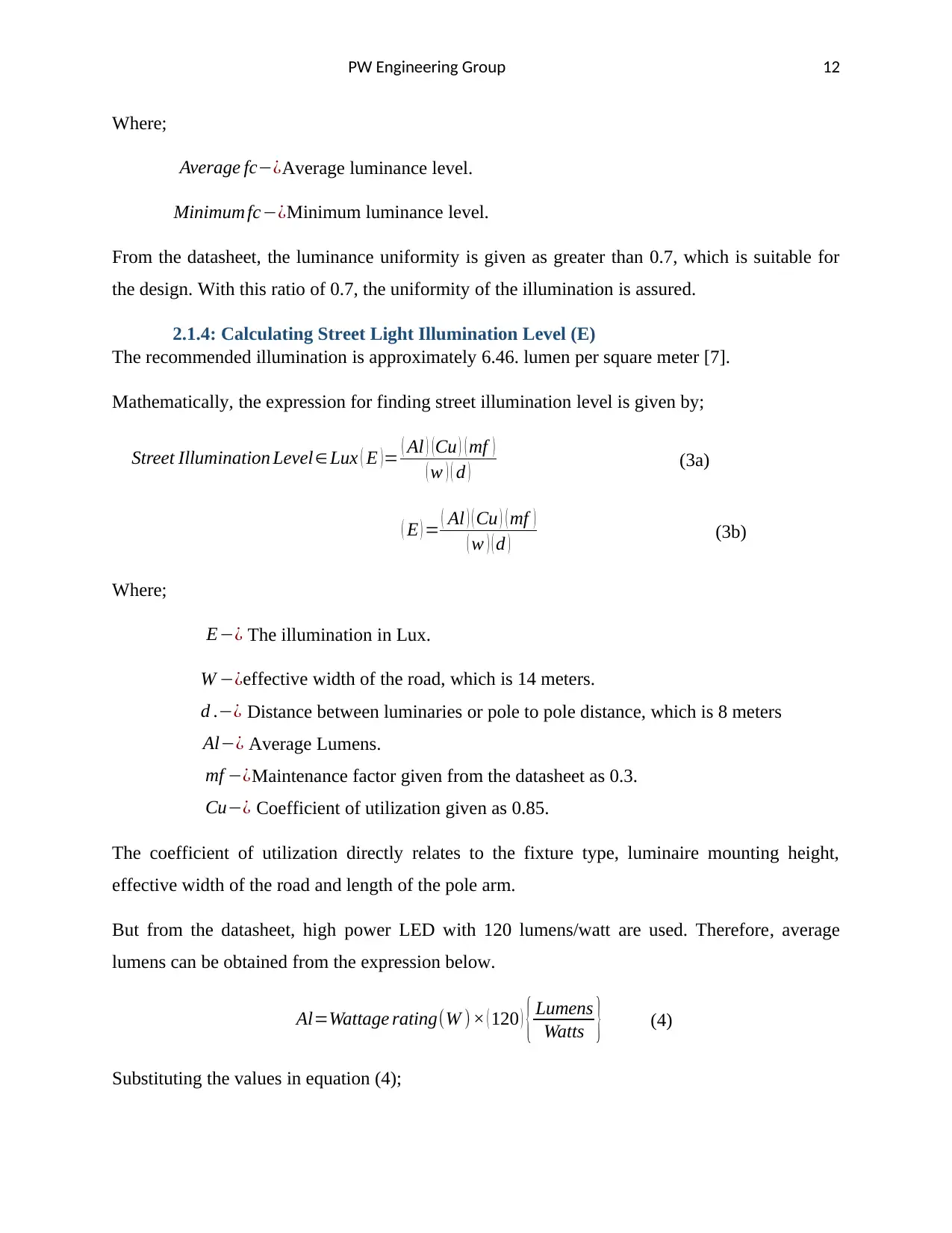
PW Engineering Group 12
Where;
Average fc−¿Average luminance level.
Minimum fc−¿Minimum luminance level.
From the datasheet, the luminance uniformity is given as greater than 0.7, which is suitable for
the design. With this ratio of 0.7, the uniformity of the illumination is assured.
2.1.4: Calculating Street Light Illumination Level (E)
The recommended illumination is approximately 6.46. lumen per square meter [7].
Mathematically, the expression for finding street illumination level is given by;
Street Illumination Level∈Lux ( E )= ( Al ) (Cu ) ( mf )
( w ) ( d ) (3a)
( E ) = ( Al ) ( Cu ) ( mf )
( w ) ( d ) (3b)
Where;
E−¿ The illumination in Lux.
W −¿effective width of the road, which is 14 meters.
d .−¿ Distance between luminaries or pole to pole distance, which is 8 meters
Al−¿ Average Lumens.
mf −¿Maintenance factor given from the datasheet as 0.3.
Cu−¿ Coefficient of utilization given as 0.85.
The coefficient of utilization directly relates to the fixture type, luminaire mounting height,
effective width of the road and length of the pole arm.
But from the datasheet, high power LED with 120 lumens/watt are used. Therefore, average
lumens can be obtained from the expression below.
Al=Wattage rating(W ) × ( 120 ) { Lumens
Watts } (4)
Substituting the values in equation (4);
Where;
Average fc−¿Average luminance level.
Minimum fc−¿Minimum luminance level.
From the datasheet, the luminance uniformity is given as greater than 0.7, which is suitable for
the design. With this ratio of 0.7, the uniformity of the illumination is assured.
2.1.4: Calculating Street Light Illumination Level (E)
The recommended illumination is approximately 6.46. lumen per square meter [7].
Mathematically, the expression for finding street illumination level is given by;
Street Illumination Level∈Lux ( E )= ( Al ) (Cu ) ( mf )
( w ) ( d ) (3a)
( E ) = ( Al ) ( Cu ) ( mf )
( w ) ( d ) (3b)
Where;
E−¿ The illumination in Lux.
W −¿effective width of the road, which is 14 meters.
d .−¿ Distance between luminaries or pole to pole distance, which is 8 meters
Al−¿ Average Lumens.
mf −¿Maintenance factor given from the datasheet as 0.3.
Cu−¿ Coefficient of utilization given as 0.85.
The coefficient of utilization directly relates to the fixture type, luminaire mounting height,
effective width of the road and length of the pole arm.
But from the datasheet, high power LED with 120 lumens/watt are used. Therefore, average
lumens can be obtained from the expression below.
Al=Wattage rating(W ) × ( 120 ) { Lumens
Watts } (4)
Substituting the values in equation (4);
⊘ This is a preview!⊘
Do you want full access?
Subscribe today to unlock all pages.

Trusted by 1+ million students worldwide
1 out of 34
Your All-in-One AI-Powered Toolkit for Academic Success.
+13062052269
info@desklib.com
Available 24*7 on WhatsApp / Email
![[object Object]](/_next/static/media/star-bottom.7253800d.svg)
Unlock your academic potential
Copyright © 2020–2025 A2Z Services. All Rights Reserved. Developed and managed by ZUCOL.
